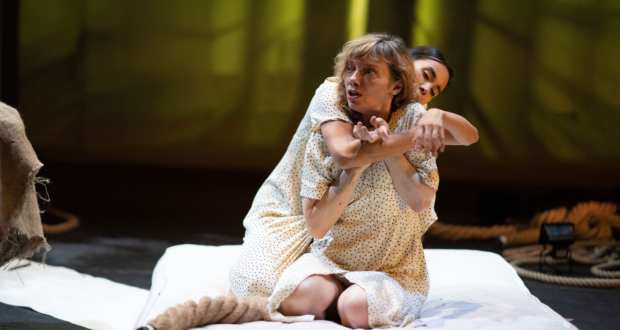A technically impressive adaptation of a seminal feminist work that challenges the realities of identity.Summary
Rating
Good
The Yellow Wallpaper is a based on a semi-autobiographical novella by Charlotte Perkins Gilman. Written in 1892, it is considered a seminal feminist work which still resonates today. Here, adapted and directed by Stephanie Mohr, it tells the tale of a woman suffering from post-partum depression. Locked in a room in a large house away from the road, her questionable treatment, prescribed by her doctor husband, is total bed-rest and deprivation of all stimulation and company. She is not allowed to write nor be creative and has no autonomy. Inevitably the space becomes claustrophobic and damaging, causing her mental health to decline. This visually ambitious production explores the maltreatment and disempowerment of women and questions the reality of female identity, whilst highlighting male coercive behaviours.
The audience enters via a small studio containing a bed and a dancer. As the protagonist relates her tale in the main auditorium, describing isolation and confinement, images from this space are projected behind her in real time and at large scale. The patient gradually becomes obsessed with the pattern she sees in the wallpaper, within which she imagines another woman moving – also in need of liberation. This person is represented through the dancer and her image. From the very start the boundaries between what is real and what is imaginary are questioned.
Aurelia Thiérrée gives a solid performance as the protagonist but although focussed and emotionally appealing, it feels like her role is a little underplayed, with the tech providing much of the work’s texture and depth. It would be nice to see her stretched further in range. Dancer Fukiko Takase is very talented, creeping furtively into every nook and cranny of the stage. Her captivating role adds interesting focus to ideas of alternative ways of being.
The impressive projected video sections by MJ Holland question the realities of the space. They draw us deeply into the claustrophobic bedroom and bring Takase’s remote images up close, allowing her to stare questioningly into the audience. Escape from physical reality is subtly suggested, removing us to the outdoors and nature, which the prisoner can only engage with mentally. The two performers are sometimes synchronised such that their isolated movements intertwine, creating a physical connection that is illusory but present nonetheless.
Meticulous sound (Mike Winship) and lighting design (Eduardo Strike) evoke a chilling sense of nervousness and ambiguity as the production moves us across and between spaces. Clarity and confusion are juxtaposed to create tension as the audience is immersed in a narrative where nothing is certain: indoors and outdoors, sanity and madness all co-exist. White noise underscores key ideas of a disrupted mind and almost hallucinatory imbalance. Strike’s work in particular supports feelings of shifting time and space, adding to the uncertain depiction of the protagonist’s world. At times it puts her behind bars, enacting her experience of mental and bodily captivity physically, yet at the same time intangibly, so once again nothing is definite although existing.
The lighting creates additional shadow people that suggest a multiplicity of female experiences being represented, none of which have actual substance yet are present, thus expanding the relevance of the individual’s tale into a much larger context.
The ambiguity spills over into the stage setting, which is covered with many items, including ropes, a fallen chair, and clothes hanging in mid-air. However, it isn’t always clear why these are there or what the metaphor is supposed to be.
This is an innovative production which in its nature challenges definitive interpretation, complementing the original text, effectively producing an immersive atmosphere of tense uncertainty and challenge. Ultimately, however, the whole feels a little incohesive, despite some impressive component parts.
Based on the short story by: Charlotte Perkins Gilman
Adapted and directed by: Stephanie Mohr
Lighting Design by: Eduardo Strike
Sound Design by: Mike Winship
Video Consultant: MJ Holland
The Ye;;pw Wallpaper plays at The Coronet Theatre until 7 October. Further information and bookings can be found here.
 Everything Theatre Reviews, interviews and news for theatre lovers, London and beyond
Everything Theatre Reviews, interviews and news for theatre lovers, London and beyond



